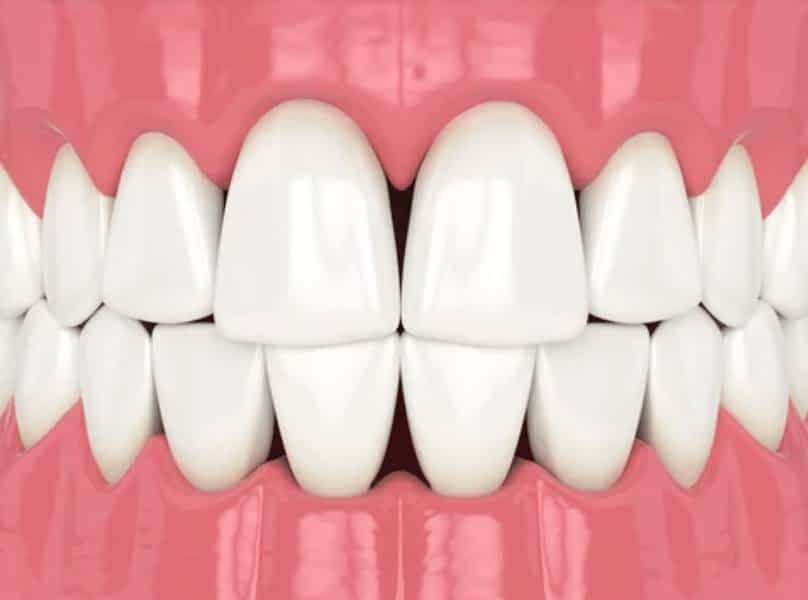
How your dentist can help with black triangles between your teeth
If someone says to you ‘black triangles,’ what does it make you think of? What is the first thing that springs to mind?
This term can conjure up all sorts of associations and meanings. Since we are dentists, it’s safe to say we are not referring to the faceless soldiers from Squid Game, symbolised by one of 3 iconic black shapes. However, the curse of the black triangles can have an equally dramatic effect on facial aesthetics since they affect the appearance of your teeth.
Black Triangles, or Gingival Embrasures as they are clinically known, is the term to describe the dark spaces that appear between the teeth, casting a crooked, witchy look on our smile. You may have been blissfully unaware of such a condition for most of your life, but as you age its more likely that these formations occur. Don’t feel surprised that they may have just crept up on you. It’s not something that you will have noticed in your more youthful-toothed years. You don’t need to feel that this is a unique, personal affliction as it affects many of our patients in their more mature years.
So, let’s dive into the dark abyss to discover what these mysterious silhouettes are all about and what as dentists we can do to help.
Why do I have black triangles between my teeth?
It’s important to mention when referring to black triangles that we are not referring to the more typical problem of gaps between teeth. Gaps between our teeth can occur at any age and are typically due the correlation between the size of our jaw and the distribution of our teeth. This is usually fixed through orthodontic treatment in the way of braces or Invisalign to evenly align the teeth side by side and close any unwanted spaces.
In this case, we are referring to a space that has formed closer to the gum line which widens as it reaches the root, creating this triangle-like shape. With black triangles, the edges of your teeth can remain perfectly connected, which may lead you to wonder what may be happening.
Whilst it seems that it is your teeth that have caused the black triangles to form, it actually has more to do with your gum health. In a perfectly healthy smile, we have what is called the ‘Papilla’ gum which looks like a small pointy piece of tissue between each tooth. This helps to secure and protect the tooth and gives us a wave-shaped contour along the gum line.
As we age, the Papilla gum tissue can start to erode, pulling away from the teeth they were designed to protect. This can be caused for a number of reasons:
• Overly aggressive brushing
• Poor oral hygiene
• Smoking
• Gum disease
• Bone loss
• Angle of tooth roots
• Pregnancy
• Diabetes
Since most of these factors develop later in life you can understand why it is far more common in the adult population. According to the British Journal of Applied Science and Technology ‘black triangles were found in 67% of the population over 20 years of age compared with 18% in the population under 20 years of age.’
With such a high incidence rate among adults, you needed worry that you are alone with this problem but you probably want to know what the solution is.
What is the problem with black triangles?
The issue with black triangles is three-fold.
Aesthetic
This is probably the first that hits you. Your teeth simply don’t look their best anymore. The little black windows formed by the triangles can make your smile look tired, worn and lacklustre. This might make you feel self-conscious about smiling or add years that you don’t deserve to your facial appearance.
Practical
The triangular gaps can cause food, liquids and air to escape from the mouth at the most unexpected moments. This can result in whistling, spitting and dribbling while eating or speaking, which is highly inconvenient in everyday life.
Health
Black triangles are a warning sign that your gums are suffering from ill health. If your gums have begun to recede, you are likely to be experiencing some level of gingivitis or even periodontitis which needs to be nipped in the bud before it gets out of control. Furthermore, the absent papilla gum tissue creates the ideal food trap for plaque and tartare to breed and attack the teeth.
So, let’s get this nipped in the bud sooner rather than later. Here are some of the solutions your dentist can offer to eliminate black triangles in teeth.
Veneers
Veneers are an option to mask the black holes that have formed as a result of the receding gum tissue. Your dentist can apply a layer of porcelain to the front of the teeth that are shaped uniquely to fill the empty spaces.
With porcelain veneers, your existing teeth will need to be prepared to accommodate their new veneer covers. However, not only will your black triangles be a thing of the past, you’ll have a strong, stain-resistant new collection of teeth in the colour of your choice that will give your smile a total transformation.
Composite Bonding
In addressing the problem of black triangles, Composite Bonding works much the same way as Veneers in that it will disguise the empty spaces by filling in the gaps. There are some key differences worth noting between these two options, however.
Instead of porcelain, Composite Bonding involves using a resin material which makes the treatment both fast and more affordable. It requires little to no preparation as the resin is moulded and bonded to the existing tooth structure. It requires the expertise of a skilled cosmetic dentist to sculpt the perfect tooth shape but can be done in the chair usually in just one sitting.
Crowns
Unlike Veneers and Composite Bonding which cover just the front, visible surface of the teeth a crown provides full coverage of the tooth. If designed in the right way a new crown can serve to both repair a broken tooth and fill the triangular gaps.
It’s important to discuss with your dentist which of these tooth restoration procedures would be best for your particular case, taking into consideration your overall oral health.
Tissue Grafting
Since gum tissue does not grow back when it’s gone it’s gone for good. Therefore, should you wish to close the black triangles by restoring the natural contours of your gum line, rather than compensating with the teeth, the only option would be tissue or gum grafting.
Similarly, to how burns victims are treated, the tissue would be harvested from another part of the mouth and attached to the areas lacking in gum. This would provide improved coverage to the teeth thereby reducing the visibility of the unsightly triangles.
Preventative Measures
As always, we cannot fail to mention the importance of preventative measures. If black triangles have already started to appear between your teeth, your gums are in need of some serious TLC. Black triangles are certainly an annoyance, but if your gums are left to deteriorate any further, you’ll be in danger of losing teeth completely. This will lead to a whole other scenario of dental treatment to address a ‘missing teeth’ situation.
Keeping your teeth and gums health should hit the top of your priority list if you are already at the mercy of the dreaded black triangles. This should include:
• Bi-annual checkups by your dentist
• Professional hygienist clean at least once per year
• Brushing twice a day
• Flossing after every brush
• Following a nutritious, balanced diet
If you are concerned about black triangles, or simply would like to kick start a new approach to your overall oral health, please book in to see us!








